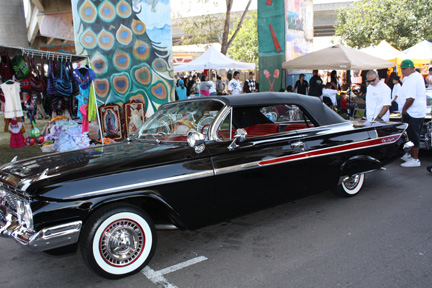On a Mission to Transform

San Francisco’s colorful and culturally diverse Mission District is a vibrant community that is home to immigrant and low-income families who are no strangers to struggle and survival. The of the Mission District is a neighborhood hit hard by unemployment, gentrification and violence that continue to displace communities. In the midst of forced removal and social unrest, exist a people who are determined to retain their roots, firmly planted in their community.
The ancestry of Mission residents, many of whom are of North, and Central American descent, is reflected on store front murals, where dull brick walls become beautiful canvases that give visibility to a people oftentimes ignored by the dominant society. In Benjamin Bratt’s latest film, La Mission, writer, producer and director Peter Bratt, pays homage to the barrio that helped shape the Bratt brothers’ identity, and celebrates the affirmation of ancestral pride that is an emblem of Latino culture. La Mission also shines light upon another symbol of Latino pride, the lowrider.
In the film, the main character, Che Rivera (Benjamin Bratt) is a member of one of the Mission’s first low rider clubs. Che is a single father, Muni bus driver, reformed inmate, and lowrider aficionado who dedicates his time building low rider cars. Throughout the film Che teaches neighborhood youth to value their Mexican identity and reminds members of his multicultural community to “Stay Brown!” The film illustrates how this affirmation of self-love is vital to communities who are perceived as inferior by the larger society.
While the lowrider culture is most often misrepresented in the media as a symbol of gang affiliation, for brown and black youth, the fact is, lowriding is a uniquely American art form rooted in the affirmation of cultural identity. The lowrider was and remains an expression of pride initiated by Mexican American youth in the southwest during the late 1930’s. 70 years after its initiation lowriding has expanded its influence to become a global culture, with lowrider clubs throughout Europe and Asia. What makes the history of lowriding even more intriguing is the history of self-determination that it is rooted in.
To understand the significance of cultural preservation within Mexican American culture it is necessary to reflect on The Treaty of Guadalupe Hidalgo of 1848, which ceded 55% of Mexican territory to the United States. Mexicans who had suddenly become Americans found themselves powerless, through the manipulation and seizure of land rights, the lack of knowledge of the English Language, and through deceptive laws that sought to make Mexican Americans second class citizens.
90 years after The Treaty of Guadalupe Hidalgo was signed, lowriding not only became a vehicle through which Mexican Americans could affirm their cultural pride, the cars themselves became a physical representation of their opposition to America’s adverse attitudes towards them. The low-rider became the antithesis to America’s automotive trend and defied the mainstreams definition of progress.
The end of World War 2 ushered in a new assembly of cars called hot rods that boasted speed and height. These cars became markers for middle class status. For lower class Americans, restricted by meager wages, many resorted to junkyards to restore throwaway cars. With their skillful hands and creative sensibility, pieces of junk were transformed into authentic works of art. While the mainstream valued brand new cars that rode high and moved fast, lowriders opposed this trend by driving cars slowly and dropping them as low to the ground as possible, and the lowrider motto, low and slow, was born.
Overtime lowriders became more elaborate and detailed with hydraulics and murals that symbolized cultural preservation, pride and perseverance. On the hoods of lowriders Mexican history that was not taught in schools was depicted and celebrated. Just as Che’s affirmation to “Stay Brown!” is echoed throughout the film, the lowrider boldly and vividly makes the statement to Amer-ica that, “You may choose not to see us, but we are here! We see ourselves. We love who we are, and we are proud!”
Affirmations’ of cultural identity are weaved throughout La Mission’s rich story, which explores the ties between family and community, and provides a meaningful critique of socially accepted values that breed racism, sexism and homophobia. Peter Bratt directly addresses the negative impact of homophobic attitudes that are prevalent throughout society and within the lowrider community.
In this way La Mission provides the lowrider community, a community that is no stranger to oppression and discrimination, an opportunity to transform some of the oppressive attitudes that exist within the culture, such as machismo and homophobia. La Mission serves as a reminder that all forms of violence and discrimination are unacceptable, and challenges viewers to see the connection between social perceptions, cultural values, and social inequities.
For more information on the film and a listing of San Diego theatres playing La Mission, visit: http://www.lamissionthemovie.com






